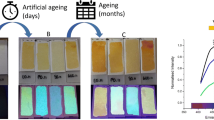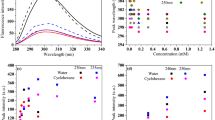Abstract
Two-photon fluorescence (TPF) of olive oils is discovered and observed experimentally for the first time. Variations of the single-photon fluorescence (SPF) and TPF with the excitation wavelength are investigated for four different olive oils. The results show that fluorescence of the cosmetic olive oils (COO) is very weak and exhibits only one spectral peak around 490 nm. While for the ordinary edible oils (OEO) whether they are during their shelf life or not, their fluorescence spectra may exhibit multiple peak structures. The short-term natural expiration only slightly weakens TPF of OEO. Moreover, the excitation wavelength affects the OEO spectra considerably in terms of the spectral peak number, the spectral peak position, and spectral shapes. When the excitation wavelength decreases from 700 nm, the whole TPF of the OEO also decreases. Relatively, however, the short wave band will decrease and disappear more quickly. While for the SPF, the long wave band will decrease and disappear first. The optimal excitation wavelengths to make the TPF strongest are around 700 nm and 640 nm for OEOs and COO, respectively. And effects of temperature on SPF and TPF of extra virgin olive oil are also explored. This work may be of significance for its potential applications in TPF detection and two-photon laser.







Similar content being viewed by others
Data Availability
All the data and materials from this manuscript will be made available on request.
References
Owen RW, Giacosa A, Hull WE, Haubner R, Würtele G, Spiegelhalder B, Bartsch H (2000) Olive-oil consumption and health: the possible role of antioxidants. Lancet Oncol 1:107–112. https://doi.org/10.1016/s1470-2045(00)00015-2
Paiva-Martins F, Rodrigues V, Calheiros R, Marques MP (2011) Characterization of antioxidant olive oil biophenols by spectroscopic methods. J Sci Food Agric 91:309–314. https://doi.org/10.1002/jsfa.4186
Cicerale S, Lucas L, Keast R (2010) Biological activities of phenolic compounds present in virgin olive oil. Int J Mol Sci 11:458–479. https://doi.org/10.3390/ijms11020458
Xiong B, Sumner D, Matthews W (2014) A new market for an old food: the U.S. demand for olive oil. Agric Econ 45:107–118. https://doi.org/10.1111/agec.12133
Vaclavik L, Cajka T, Hrbek V, Hajslova J (2009) Ambient mass spectrometry employing direct analysis in real time (DART) ion source for olive oil quality and authenticity assessment. Anal Chim Acta 645:56–63. https://doi.org/10.1016/j.aca.2009.04.043
Squeo G, Caponio F, Paradiso VM, Summo C, Pasqualone A, Khmelinskii I, Sikorska E (2019) Evaluation of total phenolic content in virgin olive oil using fluorescence excitation-emission spectroscopy coupled with chemometrics. J Sci Food Agric 99:2513–2520. https://doi.org/10.1002/jsfa.9461
Bagur-González MG, Pérez-Castaño E, Sánchez-Viñas M, Gázquez-Evangelista D (2015) Using the liquid-chromatographic-fingerprint of sterols fraction to discriminate virgin olive from other edible oils. J Chromatogr A 1380:64–70. https://doi.org/10.1016/j.chroma.2014.12.052
Mahesar SA, Lucarini M, Durazzo A, Santini A, Lampe AI, Kiefer J (2019) Application of infrared spectroscopy for functional compounds evaluation in olive oil: a current snapshot. J Spectrosc 2019:5319024–5319011. https://doi.org/10.1155/2019/5319024
Qiu J, Hou HY, Yang IS, Chen XB (2019) Raman spectroscopy analysis of free fatty acid in olive oil. Appl Sci 9:4510. https://doi.org/10.3390/app9214510
Nam A-M, Bighelli A, Tomi F, Casanova J, Paoli M (2017) Quantification of squalene in olive oil using C-13 nuclear magnetic resonance spectroscopy. Magnetochemistry 3:34. https://doi.org/10.3390/magnetochemistry3040034
Dankowska A, Kowalewski W (2019) Comparison of different classification methods for analyzing fluorescence spectra to characterize type and freshness of olive oils. Eur Food Res Technol 245:745–752. https://doi.org/10.1007/s00217-018-3196-z
Mu TT, Chen SY, Zhang YC, Chen H, Guo P, Meng FD (2016) Portable detection and quantification of olive oil adulteration by 473-nm laser-induced fluorescence. Food Anal Methods 9:275–279. https://doi.org/10.1007/s12161-015-0199-2
Dupuy N, Dréau YL, Ollivier D, Artaud J, Pinatel C, Kister J (2005) Origin of French virgin olive oil registered designation of origins predicted by chemometric analysis of synchronous excitation-emission fluorescence spectra. J Agric Food Chem 53:9361–9368. https://doi.org/10.1021/jf051716m
Zhang YC, Li T, Chen H, Chen SY, Guo P, Li Y (2019) Excitation wavelength analysis of a laser-induced fluorescence technique for quantification of extra virgin olive oil adulteration. Appl Opt 58:4484–4491. https://doi.org/10.1364/AO.58.004484
Maurya SK, Dutta C, Goswami D (2017) Concentration dependent approach for accurate determination of two-photon absorption cross-section of fluorescent dye molecule. J Fluoresc 27:1399–1403. https://doi.org/10.1007/s10895-017-2076-4
Satapathi S, Li L, Kumar A, Huo HB, Anandakathir R, Shen MY, Samuelson LA, Kumar J (2011) Strong two-photon-induced fluorescence from a highly soluble polythiophene. Opt Commun 284:3612–3614. https://doi.org/10.1016/j.optcom.2011.03.048
Qiao LL, He F, Wang C, Liao Y, Cheng Y, Sugioka K, Midorikawa K, Pan CG, Wei XB (2011) Fabrication of a micro-optical lens using femtosecond laser 3D micromachining for two-photon imaging of bio-tissues. Opt Commun 284:2988–2991. https://doi.org/10.1016/j.optcom.2011.01.082
Giovacchino LD, Sestili S, Vincenzo DD (2002) Influence of olive processing on virgin olive oil quality. Eur J Lipid Sci Technol 104:587–601. https://doi.org/10.1002/1438-9312(200210)104:9/10<587::AID-EJLT587>3.0.CO;2-M
Snouber JA, Abdelraziq I, Abu-Jafar M, Zyoud A, Hilal H, Pasqualone A (2019) Physical and chemical behaviour of Nabali Mohassan single-cultivar olive oil during prolonged storage. J Sci Food Agric 99:2757–2762. https://doi.org/10.1002/jsfa.9477
Cohoon GA, Kieu K, Norwood RA (2014) Observation of two-photon fluorescence for Rhodamine 6G in microbubble resonators. Opt Lett 39:3098–3101. https://doi.org/10.1364/OL.39.003098
Sikorska E, Khmelinskii I, Sikorski M (2012) Analysis of olive oils by fluorescence spectroscopy: methods and applications. Olive Oil-Constituents, Quality, Health Properties and Bioconversions 2012:63–88. https://doi.org/10.5772/30676
Saleem M, Ahmad N, Ali H, Bilal M, Khan S, Ullah R, Ahmed M, Mahmood S (2017) Investigating temperature effects on extra virgin olive oil using fluorescence spectroscopy. Laser Phys 27:125602. https://doi.org/10.1088/1555-6611/aa8cd7
Escuderos ME, Sayago A, Morales MT, Aparicio R (2009) Evaluation of α-tocopherol in virgin olive oil by a luminiscent method. Grasas Aceites 60:336–342. https://doi.org/10.3989/gya.108308
Nikolova K, Eftimov T, Perifanova M, Brabant D (2012) Quick fluorescence method for the distinguishing of vegetable oils. J Food Eng 2:674–684. https://doi.org/10.17265/2159-5828/2012.12.002
Kongbonga YGM, Ghalila H, Onana MB, Majdi Y, Lakhdar ZB, Mezlini H, Sevestre-Ghalila S (2011) Characterization of vegetable oils by fluorescence spectroscopy. Food Nutr Sci 2:692–699. https://doi.org/10.4236/fns.2011.27095
Kyriakidis NB, Skarkalis P (2000) Fluorescence spectra measurement of olive oil and other vegetable oils. J AOAC Int 83:1435–1439. https://doi.org/10.1093/jaoac/83.6.1435
Kıralan SS, Toptanci İ, Abacıgil TÖ, Ramadan MF (2020) Phthalates levels in olive oils and olive pomace oils marketed in Turkey. Food Addit Contam A 37:1332–1338. https://doi.org/10.1080/19440049.2020.1766120
Lioupi A, Nenadis N, Theodoridis G (2020) Virgin olive oil metabolomics: a review. J Chromatogr B 1150:122161. https://doi.org/10.1016/j.jchromb.2020.122161
Rotich V, Riza DFA, Giametta F, Suzuki T, Ogawa Y, Kondo N (2020) Thermal oxidation assessment of Italian extra virgin olive oil using an UltraViolet (UV) induced fluorescence imaging system. Spectrochim Acta A 237:118373. https://doi.org/10.1016/j.saa.2020.118373
Guimet F, Ferré J, Boqué R (2005) Rapid detection of olive-pomace oil adulteration in extra virgin olive oils from the protected denomination of origin "Siurana" using excitation-emission fluorescence spectroscopy and three-way methods of analysis. Anal Chim Acta 544:143–152. https://doi.org/10.1016/j.aca.2005.02.013
Cheikhousman R, Zude M, Bouveresse DJ-R, Léger CL, Rutledge DN, Birlouez-Aragon I (2005) Fluorescence spectroscopy for monitoring deterioration of extra virgin olive oil during heating. Anal Bioanal Chem 382:1438–1443. https://doi.org/10.1007/s00216-005-3286-1
Funding
The work is supported by Sichuan Science and Technology Program (No.2020YJ0431).
Author information
Authors and Affiliations
Contributions
Zhong XQ conceived the research thought, designed the experimental scheme, revised and edited the manuscript. Xu JM processed and analyzed the experimental data, organized the figures in the manuscript, and wrote the first draft of the manuscript. Xu JM, Sun MY, Chen QL, Zeng ZK, and Chen YS performed fluorescence measurements. Cheng K provided assistance for the experiments and participated in discussing and demonstrating the research results.
Corresponding author
Ethics declarations
Conflict of Interest
There are no conflicts to declare.
Additional information
Publisher’s Note
Springer Nature remains neutral with regard to jurisdictional claims in published maps and institutional affiliations.
Rights and permissions
About this article
Cite this article
Xu, J., Zhong, X., Sun, M. et al. Two-Photon Fluorescence Study of Olive Oils at Different Excitation Wavelengths. J Fluoresc 31, 609–617 (2021). https://doi.org/10.1007/s10895-021-02692-6
Received:
Accepted:
Published:
Issue Date:
DOI: https://doi.org/10.1007/s10895-021-02692-6




